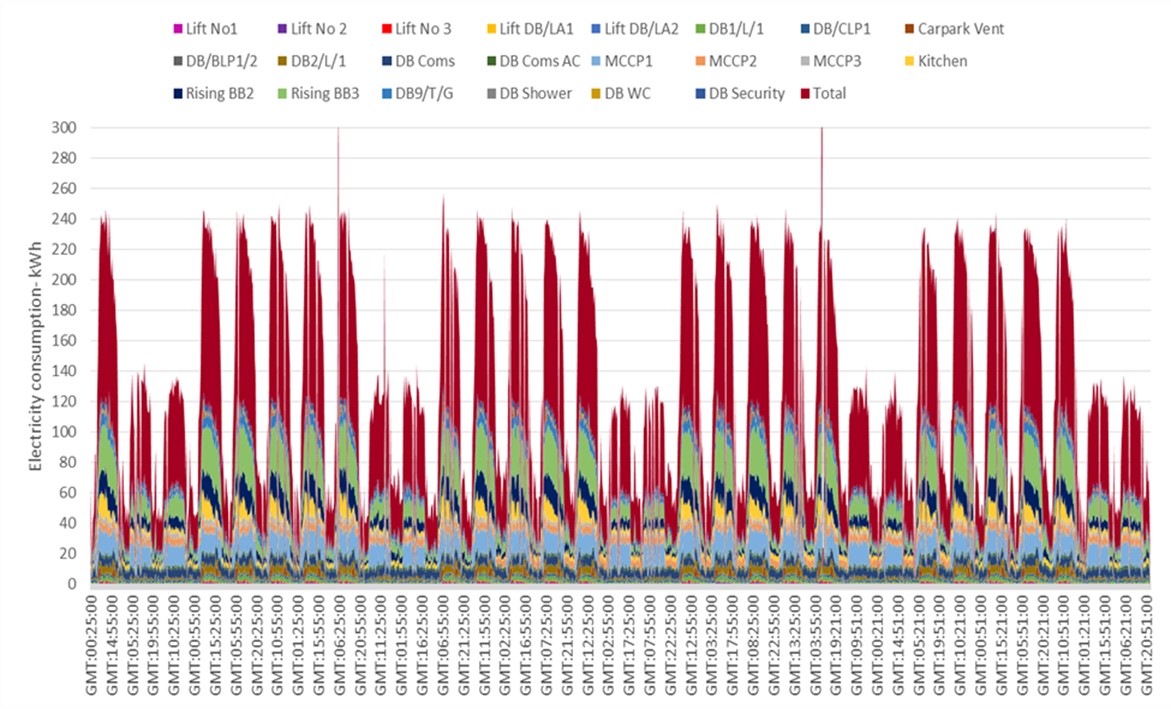Regulated and unregulated energy consumption

|
Contents |
[edit] Introduction
A building’s energy consumption varies considerably according to the building’s function. Its total operational energy usage comprises regulated and unregulated energy. BREEAM broadly defines regulated and unregulated energy consumption as follows:
[edit] Regulated energy
‘Regulated energy is building energy consumption resulting from the specification of controlled, fixed building services and fittings, including space heating and cooling, hot water, ventilation, fans, pumps and lighting. Such energy uses are inherent in the design of a building.’
Designers may not be able to predict how the services and fittings will be used but they can design them to be as energy efficient as possible.
NB The Home Quality Mark One, Technical Manual SD239, England, Scotland & Wales, published by BRE in 2018 defines a regulated energy as; ‘…building energy consumption resulting from the specification of controlled, fixed building services and fittings, including space heating and cooling, hot water, ventilation and lighting.’
[edit] Unregulated energy
Unregulated energy is building energy consumption resulting from a system or process that is not ‘controlled’, ie energy consumption from systems in the building on which the Building Regulations do not impose a requirement. For example, this may include energy consumption from systems integral to the building and its operation, e.g. IT equipment, lifts, escalators, refrigeration systems, external lighting, ducted-fume cupboards, servers, printers, photocopiers, laptops, cooking, audio-visual equipment and other appliances.
Some buildings can have unregulated energy accounting for 50% of total energy use.
Unlike regulated energy use, unregulated energy consumption is usually only determined very late in the design process; it can also vary throughout the building lifecycle. This is because buildings may have different occupants or uses.
NB The Home Quality Mark One, Technical Manual SD239, England, Scotland & Wales, published by BRE in 2018 defines a unregulated energy as; ‘…the energy consumption of the home that is not ‘controlled’, i.e. energy consumption from aspects of the home on which Building Regulations do not impose a requirement. For the purposes of the HQM assessment, this includes energy associated with lighting, appliances and cooking.’
[edit] Building regulations
Designers usually demonstrate compliance with Approved Document L of the building regulations as evidence of a building’s energy efficiency. But this does not fully reflect reality, as regulated energy is only a part of the total. Although they can usually predict regulated energy usage, it becomes more difficult with unregulated energy as predicting user behaviour can be problematic. This means that designers should not be held accountable for total operational energy usage as it is something they can only partly influence.
[edit] Related articles on Designing Buildings Wiki
- Approved document L.
- BREEAM.
- Building Regulations.
- Energy performance certificates.
- Leadership in Energy and Environmental Design (LEED).
- New energy retrofit concept: ‘renovation trains’ for mass housing.
- Operational carbon.
- Performance gap.
- The code for sustainable homes.
[edit] External references
- Bonfield review.
- Energy Saving Trust.
- EU Energy Efficiency Directive.
- Part L (Conservation of fuel and power).
- Planning Portal – Energy Saving.
Featured articles and news
Ebenezer Howard: inventor of the garden city. Book review.
The Grenfell Tower fire, eight years on
A time to pause and reflect as Dubai tower block fire reported just before anniversary.
Airtightness Topic Guide BSRIA TG 27/2025
Explaining the basics of airtightness, what it is, why it's important, when it's required and how it's carried out.
Construction contract awards hit lowest point of 2025
Plummeting for second consecutive month, intensifying concerns for housing and infrastructure goals.
Understanding Mental Health in the Built Environment 2025
Examining the state of mental health in construction, shedding light on levels of stress, anxiety and depression.
The benefits of engaging with insulation manufacturers
When considering ground floor constructions.
Lighting Industry endorses Blueprint for Electrification
The Lighting Industry Association fully supports the ECA Blueprint as a timely, urgent call to action.
BSRIA Sentinel Clerk of Works Training Case Study
Strengthening expertise to enhance service delivery with integrated cutting-edge industry knowledge.
Impact report from the Supply Chain Sustainability School
Free sustainability skills, training and support delivered to thousands of UK companies to help cut carbon.
The Building Safety Forum at the Installershow 2025
With speakers confirmed for 24 June as part of Building Safety Week.
The UK’s largest air pollution campaign.
Future Homes Standard, now includes solar, but what else?
Will the new standard, due to in the Autumn, go far enough in terms of performance ?
BSRIA Briefing: Cleaner Air, Better tomorrow
A look back at issues relating to inside and outside air quality, discussed during the BSRIA briefing in 2023.
Restoring Abbotsford's hothouse
Bringing the writer Walter Scott's garden to life.
Reflections on the spending review with CIAT.
Retired firefighter cycles world to raise Grenfell funds
Leaving on 14 June 2025 Stephen will raise money for youth and schools through the Grenfell Foundation.
Key points for construction at a glance with industry reactions.






















